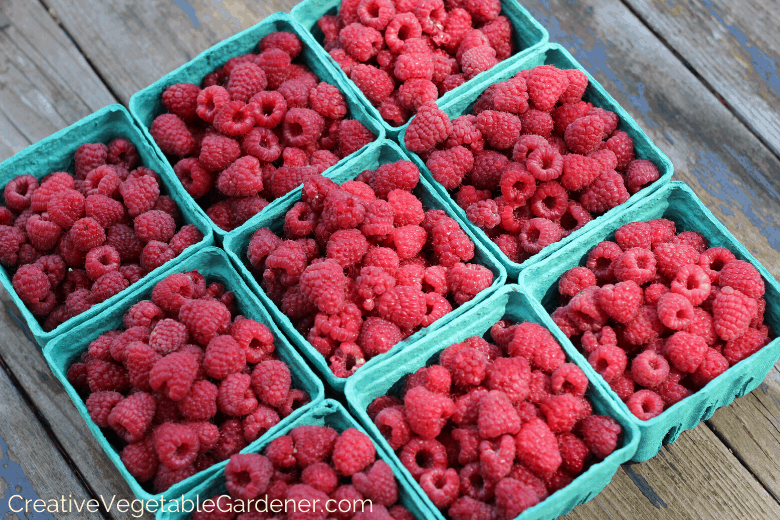
Everything you need to know about planting raspberry canes in your garden for years of abundant and sweet harvests of this delectable berry.
If adding freshly harvested berries to your morning oatmeal sounds like a garden fantasy come true, then planting raspberry canes in your yard should be on your spring to-do list this season!
In my yard, I have two rows of raspberries and at the peak of the summer, I harvest a big bowl each morning. Sometimes that’s more raspberries than we can eat! If there is such a thing…
Although I would put raspberries on my easy to grow fruit list, there are some special considerations you should mull over before you dig in and start planting.
In this post, I’ll share some of my best tips for choosing which varieties to grow, a guide to planting raspberry canes in your yard, and how to set your patch up for success and more.
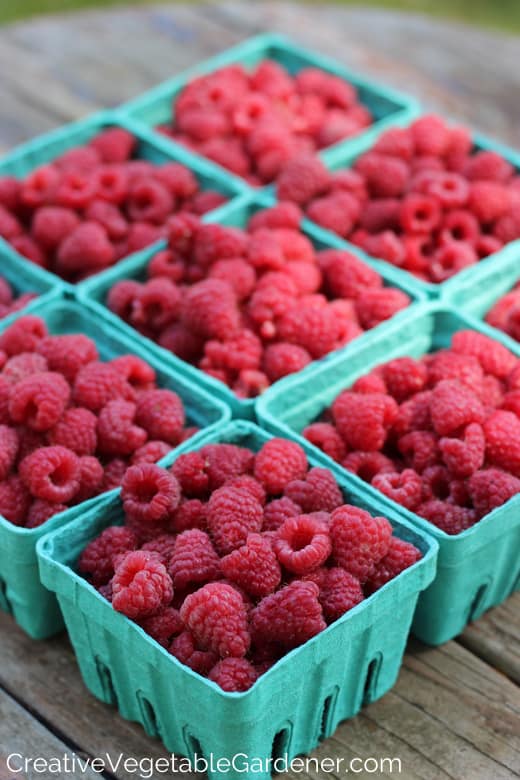 This post contains affiliate links.
This post contains affiliate links.
Tips and Tricks for Growing Great Raspberries
How to Choose Which Raspberry Type to Grow
There are red, purple, yellow and black raspberry varieties to choose from. This post is primarily focused on growing red raspberries, the type most commonly found in your local grocery store. Most red raspberry varieties perform best in gardening zones 3-8.
There are two types of raspberries – summer-bearing and everbearing/fall-bearing. I’ll refer to the second type as fall-bearing in this post since I think it’s an easier name to understand.
Summer bearing raspberries usually produce a harvest for several weeks between late June and early August, depending on where your garden is located. My zone 5 summer-bearing raspberries start pumping out fruit in mid-July. Yum!
The other important thing to know about summer bearing raspberries is that they produce fruit on second-year canes, called floricanes. We’ll come back around to this little tidbit when we talk about pruning.
Fall bearing raspberries are ready for harvest in late summer and early fall – usually mid-July through the end of September.
The fruit of these varieties grows on first-year canes, called primocanes. Again, this will be extremely important to know when it’s time to prune.
If you have the room in your yard, I highly recommend planting at least one row of each type – summer bearing and fall-bearing.
This will provide you with a consistent harvest of raspberries over the course of the entire summer and early fall. There’s no such thing as too many weeks full of raspberries, am I right?!
But, you’ll need to keep these two types separated by quite a bit of space so you know the difference between the two for pruning maintenance.

Photo by Annie Spratt on Unsplash
When to Plant & Where to Buy Raspberry Canes
The best time to plant raspberry canes is in the spring. This is also when most nurseries are selling their fruit and berry bushes and trees.
You could wait until fall to plant as well, but I find at that time of year it’s difficult to track down raspberry canes. Even the mail order nurseries tend to run out of stock by the end of the season.
In my zone 5 garden, I try to plant fruit trees, bushes, and canes in early to mid-May. That way they have some time to get established before the hot and drier weather of the summer months.
Raspberry canes spread very easily, so you might find out that a friend or neighbor has extra plants they’d love for you to dig up and take away.
This would be a very inexpensive and easy way to procure plants for your new raspberry patch.
If you don’t have a friendly source for canes, then I’d suggest visiting some local nurseries to scout for plants. One important caveat here – I’ve noticed a lot of nurseries selling a pot with one raspberry cane in it.
This is not an economical way to buy raspberry plants. It’s better to purchase bare-root canes, which means they don’t come in soil or a pot.
One of my local nurseries has a bare root room where they sell lots of fruit trees, berry bushes/plants/canes, and other ornamental trees and shrubs. All of the plants’ roots are exposed and sitting in a damp mixture of wood shavings and paper.
After purchase, they wrap everything up in some of the damp paper shavings and wax paper so the roots don’t dry out before planting.
They charge about $4-5 per cane, with discounts given for bundles of five and ten plants. If you can’t find bare-root canes locally then it probably will be cheaper for you to order plants online.
Here are some suggested sources for raspberry canes. This isn’t sponsored by any of the below companies, although I am an Amazon and Etsy affiliate.

Photo by Natalia Dworniak on Unsplash
Etsy is an online marketplace where individual people sell everything from arts and crafts to gardening supplies like seeds and plants.
I like shopping from this site because I know I’m purchasing from a real person who is likely a garden lover like me. I gathered many of the raspberries varieties from this post in a list on Etsy here.
Jung Seed is the local nursery from where I’ve obtained most of my plants. They also sell online and have a decent selection of varieties here.
Johnny’s Selected Seeds is a reputable source of seeds and plants and is one of my favorite companies. I order from them every year. You can find their raspberry selection here.
Raintree Nursery has a huge selection of fruit trees, berries, vines, nut trees, and even unusual edibles. It’s a dangerous catalog to peruse! I’ve ordered Alpine strawberries from them in the past. Check out their website here.
Amazon has almost everything we could possibly desire, including raspberry canes. You can find many of my recommended gardening tools, supplies, seeds, books and raspberry varieties here.
What Varieties to Choose
Ideally, you’d be harvesting raspberries for as many months of the summer and fall as possible. That means if you have space in your yard you should plant two or three different varieties that produce at different times in the season so you have a prolonged harvest.
Check the variety description to make sure it’s suited for your gardening zone. Don’t know what zone you’re in? Find out by entering your zip code here.
This bears repeating – you’ll need to keep them spread throughout your yard so that each variety is completely separate for pruning purposes.
Johnny’s has a great raspberry bundle where they include early, mid-, and late-season varieties that produce from mid-June to early August.
Or you can create your own staggered harvest by selecting various varieties and using their table here.
Fall-bearing
Anne (yellow variety)
Caroline – I grow this one.
Heritage – I grow this one.
This shop and this shop on Etsy carry a lot of the above varieties.
I also gathered several varieties found on Amazon in my storefront here.
You can’t really see them in this photo, but my raspberries are planted all the way to the right of my garden.
Choosing Where to Plant Your Raspberries
Raspberries prefer full sun in order to produce a bumper crop. If possible, plant them in an area where they will get at least 6 hours of sun per day, the more the better.
In my current yard, I prioritized putting my vegetable beds in all of the full sun areas, so my raspberries ended up in more like partial sun areas.
They’re definitely not as productive as they would be if they had more sun, but I do get a fair amount of fruit. So, work with what you have and do some experimentation.
Raspberries spread VERY easily and quickly. When I used to do garden work at other peoples’ homes I visited several people whose entire yards were taken over by raspberries that spread unchecked over the years. It was not fun to remove them!
The plants shoot out runners every season that will colonize the entire area over time if you don’t keep them in check.
This might sound great (more raspberries!) but it’s not fun to try to pick the fruit from a huge overgrown patch. The plants are prickly and don’t feel pleasant when you have to wade through them for harvesting.
They probably aren’t a crop you want in the middle of your vegetable garden either. I made this mistake when I had a community garden plot. I planted raspberries in one of the beds near the middle. It was such a pain!
They can be a bit floppy if they’re not trellised, so they were constantly blocking the paths. I would also brush against their prickly canes every time I walked by that bed.
And, new plants kept popping up amidst my vegetables all season. After a season I ripped them all out and decided that raspberries and vegetables didn’t mix.
Take a walk around your property and look for an area that gets full sun and might be underutilized. Or, you could add raspberries on the edge of or close by your vegetable garden.
Because I devoted my best areas to my vegetable garden, I picked out two different places to locate raspberries.
I planted a row of summer-bearing raspberries in a sunny corner of the back part of our property next to our compost bin. And later I added another row next to my vegetable garden in my side yard, in an area that’s right next to a large tree.
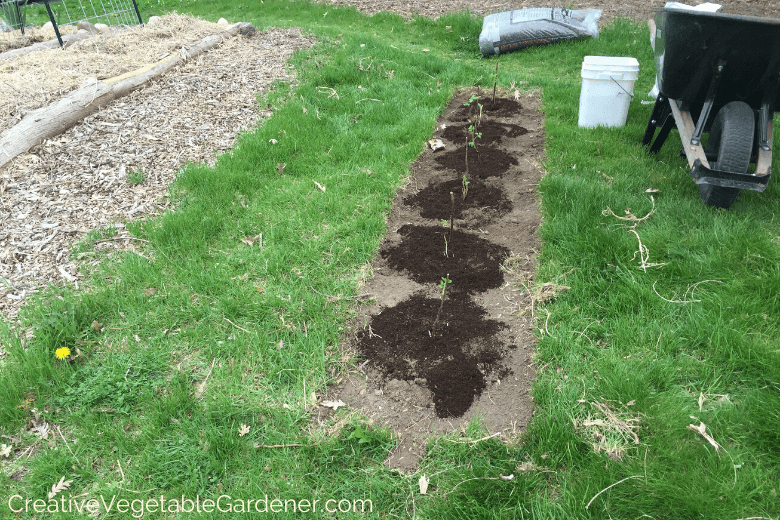
Prepping the Area & Planting Raspberry Canes
In this section, I’m going to walk you through how I planted my raspberries and then offer a simpler way that requires a little planning. I was impatient to plant raspberries the first season I moved into my house, so I chose a method that was more work but allowed me to plant them right away.
It’s best to kill or remove the grass before planting raspberries. This will make the patch easier to weed and maintain.
We’ll talk about killing the grass later in this post. I opted to remove the grass, which can be a lot of work. What makes it less work is using a manual sod stripper. This is the easiest way I’ve found to remove small amounts of grass.
You can rent gas-powered sod strippers, but they’re noisy and difficult to maneuver. They’re a good idea if you’re removing a lot of grass at once, but for small jobs, I prefer the quietness of the manual sod stripper.
They’re not the most inexpensive tool, so I rent one from a local hardware store when I need it.
But, I love it so much that I’ve contemplated buying one. I use it several times a year to remove grass for tree planting, garden bed expansion and edging.
In the listing for the tool, you can watch a video on how to use it. Check it out here.
Okay, let’s get started!
It’s best to plant raspberry canes in rows. This makes harvesting and maintenance much easier.
I removed a strip about 16 feet long and 2 ½ feet wide with the kick stripper. If you’re creating more than one bed leave at least enough width of grass in between the beds to get a lawn mower through. Mowing helps prevent the canes from filling in the aisle.
While I used the stripper, my husband (Mr. Creative Vegetable Gardener!) rolled up the sod and then transported it to the mound he was building in our front yard.
You could also compost it for a year and then add it back to a garden area when it’s broken down.
Mark used the sod to help build his front yard mound. We later planted trees and shrubs in this area.
Next, I dug a shallow hole for each plant. I lined them down the middle of the bed and spaced them two feet apart. I then added a handful of balanced fertilizer to get them off to a good start.
This is an important part, do not plant the raspberry canes too deep.
The first time I tried to grow them I killed the canes by planting them too far under the soil. The roots need to be within a few inches of the soil surface.
It might feel like you’ve planted them too shallowly, but don’t worry, they’ll be fine.
I then watered in the canes with the hose and mulched the plot thickly with woodchips. But, I pulled the woodchips away from the root areas so they weren’t covered too thickly and water could get through to them.
The woodchips will trap in moisture, keep the weeds, down, and break down to add organic matter to the soil over time. You can also use hay, straw, leaves, or grass clipping for mulch. (Read more about mulch here.)
Mulch the beds thickly with woodchips. Make sure the mulch isn’t too thick around the root zone.
Over time I’ll allow the raspberries to spread and fill in the bed to about 2’ wide. This still allows me easy access for harvesting, and gets me more raspberries!
The thing I like about this bed set up is that keeping the bed surrounded by grass prevents the canes from spreading too far outside of the bed because we’re always mowing around it.
When the canes send out a runner out it gets mowed down by the lawnmower, which keeps the patch in check.
One aspect of this set up that is a disadvantage is the grass does tend to creep into the bed over time. I spend a little time each spring weeding it out, but I don’t worry too much about it because raspberries are pretty tough. They can compete with a little grass.
If you plant a summer-bearing variety you won’t reap a raspberry harvest the season you plant them because they bear on second-year canes. Fall-bearing varieties bear on first-year canes, so you might get a few raspberries that first fall.

Other Methods of Planting Raspberry Canes
Killing the Grass
The above method of creating raspberry beds worked well for me because it’s quick and dirty and allowed me to complete the entire task in under two hours.
If you have time to plan ahead, I suggest killing the grass instead of removing it. This is a lot less work, it doesn’t strip away any of your topsoil, and you don’t have to find somewhere to compost all of the sod you removed. The best way to kill grass is to smother it.
You can lay a piece of black plastic, a tarp, or other heavy material over the grass area you want to kill and then weigh it down with rocks or logs.
Within one season the grass and weeds should be completely dead. Then you can move ahead with planting your raspberries. Easy!
I like to use cardboard and woodchips for prepping new garden areas. You can read about this method in this blog post.
Building a Raised Bed
My raspberry bed in the grass method works fine, but the grass does tend to spread into the raspberries, which annoys me. I hate weeding grass out of things!
If I had all of the time and money in the world, I would probably build raised beds for my raspberries.
I looked around the internet for a post or video from someone using this method and found a video here:
Building a Raised Bed for Raspberries on Youtube
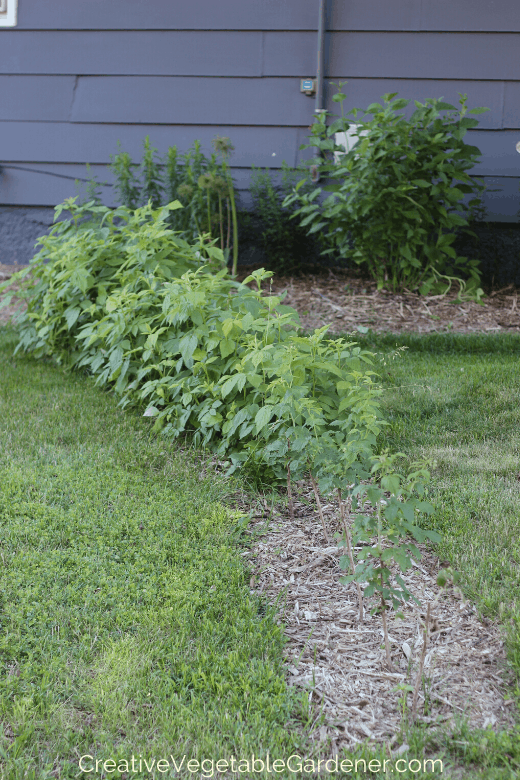
My raspberry patch establishing itself.
Care & Maintenance of Your Raspberries
Watering
In the first year of planting, you’ll need to make sure to keep them watered until they establish. This means watering every few days right after planting.
You can usually tell they’ve rooted into the ground when they start pushing out green leaves on the canes. Once you see those green leaves you can back off on watering every few days.
After this point, they’ll need about 1 inch of water every 7-10 days. If you get regular rainfall in the summer in your garden you may not have to manually water them.
If you live in a drier climate you’ll have to use a sprinkler, hose, or irrigation system to make sure they’re getting the water they need.
Much of the root system of raspberry plants is within the top foot of soil, so frequent shallow watering is better than infrequent heavy watering.
Mulching
You should never leave soil bare in your garden, including around vegetables, trees, perennials, and fruits like raspberries. The number one benefit to mulching is that it keeps down the weeds.
Yay! Less weeding = happy gardener. (Read more about mulching your vegetable garden here.)
Mulching also retains soil moisture and breaks down over time and adds organic matter to your soil. Woodchips are my mulch of choice for all woody perennials like trees and shrubs, my perennial garden, and raspberries.
They take longer to break down than other types of mulch, but you can also use straw, hay, leaves, or grass clippings.
My husband is an arborist so we always have a huge pile of free woodchips waiting to be spread around our garden.
If you have any trees taken down at your house you can ask the company to leave you the woodchips. You can check out this website to see if you can get free woodchips delivered.
Woodchips usually break down throughout the season, so it’s a good idea to apply a new, thick layer every spring.

Photo by Louis Hansel @shotsoflouis on Unsplash
Fertilizing
Raspberries are pretty hardy plants, so you don’t have to worry too much about fertilizing the heck out of them. I’d suggest spreading a balanced fertilizer or quality compost around the base of the plants in early spring each season.
You can do this after you weed the planting bed and before you apply your new layer of mulch.
Trellising
I’ve had raspberry plantings in the yard at both of my houses in Madison and I’ve never trellised them. But, every year I say I should!
Raspberry plants grow tall and have a tendency to flop over a bit on the top when the raspberries are forming because the cane gets a little top-heavy.
This makes harvesting more of a chore because you have to bend over or get on your knees to try to find the ripe raspberries.
When you trellis the canes they’ll be more upright and easier to harvest. The berries will also receive more sunlight since they won’t be shading themselves.
Here are a few trellising resources from around the internet.
Quick & Easy Raspberry Trellis, Youtube video by fellow garden blogger, Lovely Greens
Simple Staking Method, Youtube video by Michigan Gardener
DIY Raspberry Trellis, blog post by Mike’s Backyard Nursery. This is the simple method I’d be most likely to construct since I already have t-posts in my garage.

Pruning
This is the topic we’ve all been waiting for! It’s very important to make sure you’re pruning your plants correctly to ensure you get a harvest each year.
Let’s review – summer-bearing raspberries produce fruit on second-year canes (floricanes).
This means you have to be very careful about not cutting down all of the canes at the end of the season or you’ll never get a harvest.
To make it a bit more confusing, with fall-bearing raspberries you DO cut all of the canes down to the ground at the end of the season.
This is because they produce fruit on first-year canes each year (primocanes).
This is why it’s very important to #1: know which kind of raspberry you planted, summer- or fall-bearing, and #2: if you planted both summer- and fall-bearing you need to keep them distinctly separate since they are pruned very differently.
I planted my fall-bearing variety in my side yard and my summer-bearing variety in my back yard. I also wrote on my garden map which variety is planted in each area so I’ll never get mixed up.
I’ve found that I need a reminder every year exactly how to prune each variety. The University of Wisconsin Extension has a very helpful publication on growing raspberries that features a section on pruning with illustrations.
Instead of me trying to reconstruct it here, I suggest you read through that section when you’re ready to prune your plants.
You can find the pruning instructions on pg. 10 here. (If at some point this link doesn’t work just Google “UW Extension Growing Raspberries in Wisconsin and the PDF booklet should come up in the search results.)
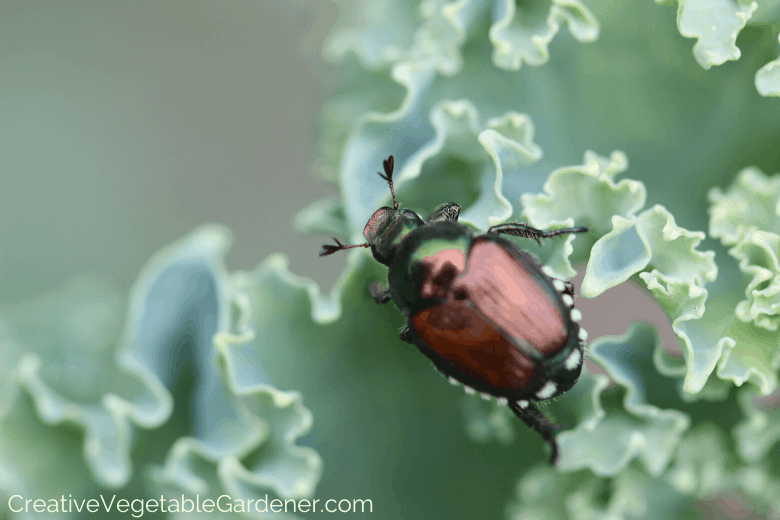
Japanese beetles, so pretty and so annoying!
Pests & Diseases
There are several pests and diseases that can impact your raspberry canes. In this section, I’m going to talk about the two I’ve had in my garden.
I’d suggest consulting the UW Extension publication on growing raspberries if you want to read more about the other pests and diseases. Find it here.
Japanese Beetles: If you live in an area that has Japanese Beetles you’re probably sighing right now and thinking to yourself, “I hate those things.” Yep, they’re a big nuisance in the garden and they especially love raspberries.
They flock to my plants every July and love to hang out and nibble on the ripening fruit. They also eat the leaves of the plants.
Unfortunately, if you take the time to read about Japanese Bettles you’ll discover there are not many effective ways of getting rid of them.
I don’t use chemicals in my garden, so I basically just deal with them.
They’re most prolific in my garden in July, so they primarily infest my summer-bearing crop. They’re usually gone from the area by the time my fall-bearing raspberries are producing a harvest.
One option would be to experiment with using a floating row cover, which I might try this year to see how it works.
I have a post about using it to protect your vegetables from frost, but it’s the same general idea when using it for pests. Read more about it here.
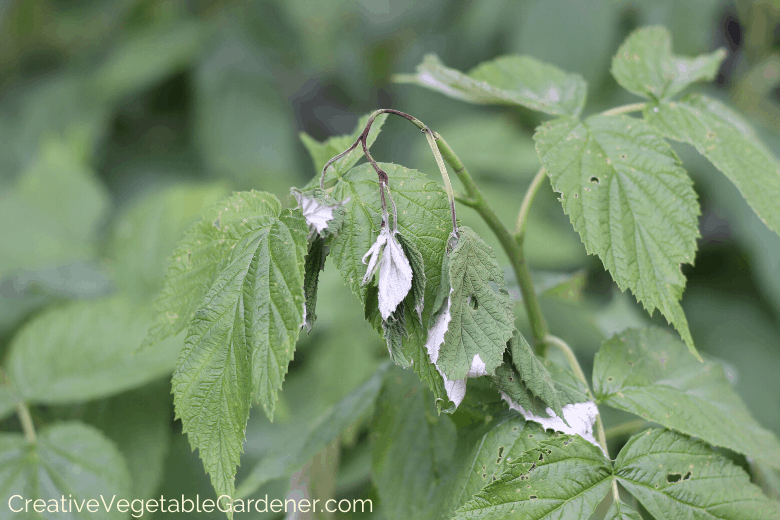
A wilted cane tip from a Raspberry Cane Borer.
Raspberry Cane Borer
One day when I was harvesting from my fall-bearing raspberry patch I noticed that several of the canes were snapped off at the tips and laying on the ground.
I figured it was the result of some kind of animal messing around in my plants and didn’t give it another thought.
Until a few days later I found more cane tips on the ground. I went inside to my computer and did a little research and discovered that my plants were being inhabited by the Raspberry Cane Borer (cue ominous music).
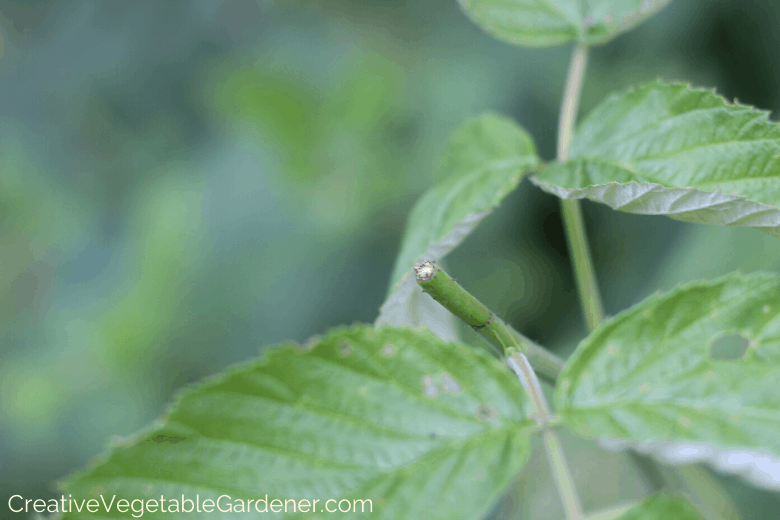
The cane top after the wilted part fell off. You should cut this down even further to get rid of the grubs.
The tops of the canes were falling off because the insect lays its eggs by puncturing holes around the stem at the top of the plant. This causes them to wilt and fall off.
The grubs travel downwards from the damaged tip and hibernate for the winter. The following season they keep moving down the cane and eventually kill it.
You can try to control these borers by removing part of the canes 5-6 inches below the puncture and disposing of that section in an attempt to get rid of the grub. Extension recommends burning the trimmed pieces to destroy the grub.

Additional Resources for Growing Raspberries
Don’t let the length of this post discourage you from planting raspberry canes in your yard. Raspberries are definitely on my list of things that are “worth it” to grow in your home garden.
They’re so expensive at the grocery store and homegrown raspberries are way tastier when they’re freshly picked in the morning sun.
Once you’re growing raspberries successfully and getting a bumper harvest you might have more than you can eat fresh. If that’s the case, you can learn several options for how to freeze raspberries.
If you’re just getting starting growing fruit at home, these books will support you in mastering the art of growing fruits and berries and inspire you to keep expanding your production area!
The author of this book, Lee Reich, has a “farmden” in upstate NY where he writes about the many delicious fruits he grows every season. He also has a blog where he shares behind the scenes gardening tips and tricks.
.
Another one of Lee Reich’s books focused on choosing the best types and varieties of fruits for your climate. The books goes in depth on 30 fruits and berries, some of them uncommon in the grocery store. He shares how to prevent pests and diseases naturally, without toxic chemicals.
.
.
In this book, you’ll learn the best varieties of strawberries, raspberries, blackberries, blueberries, gooseberries, currants, and elderberries for you, how to fit them into your landscape (including in borders and containers), and how to maintain them for peak harvest.
You won’t regret planting raspberry canes this season! It might take a few years for them to really start pumping out big harvests, but once they do, you’ll be thrilled to pop out to your garden on summer mornings and pick a handful for breakfast!
More posts about growing fruits and veggies in your yard:


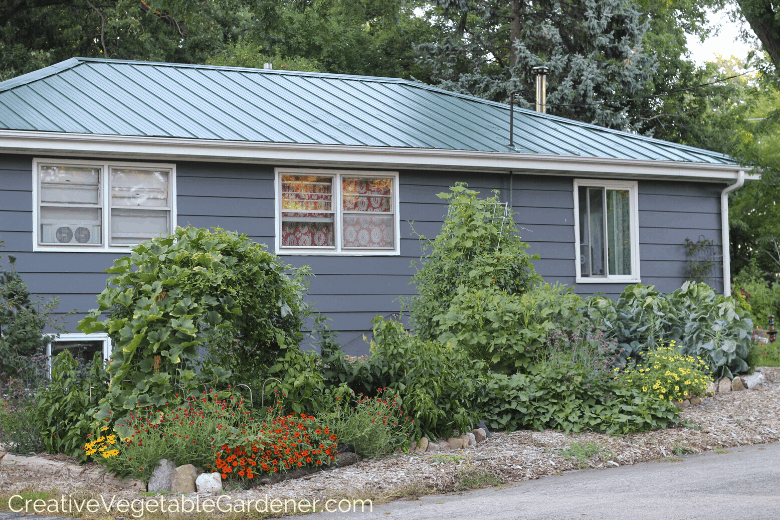

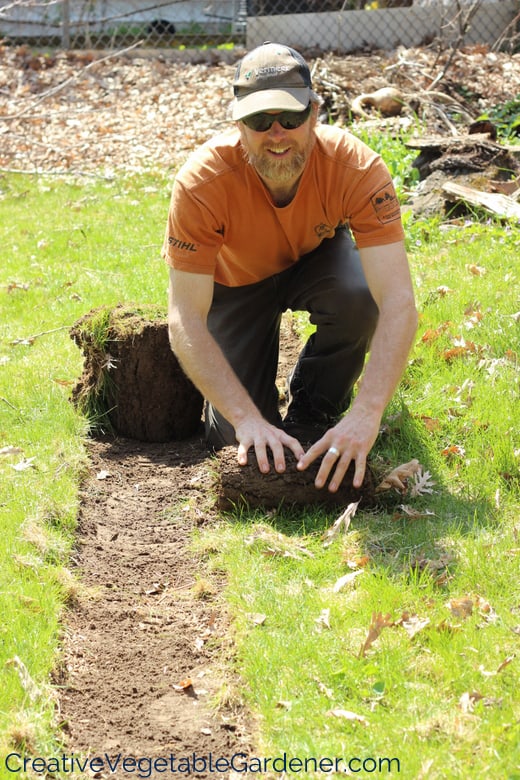
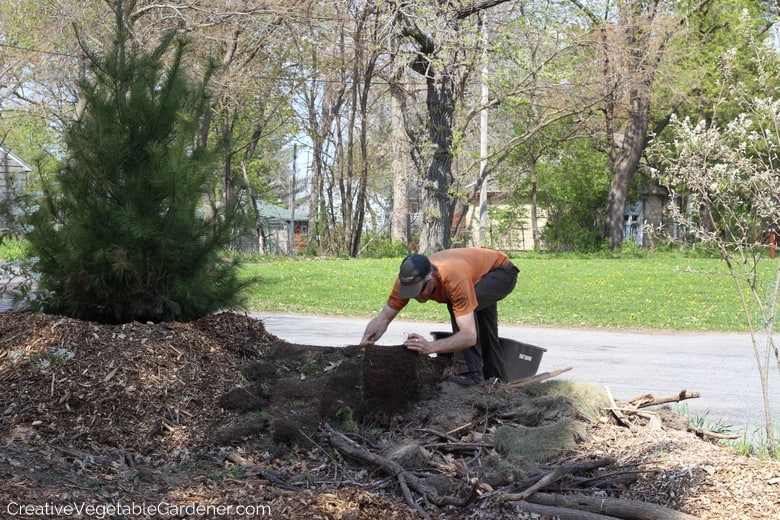

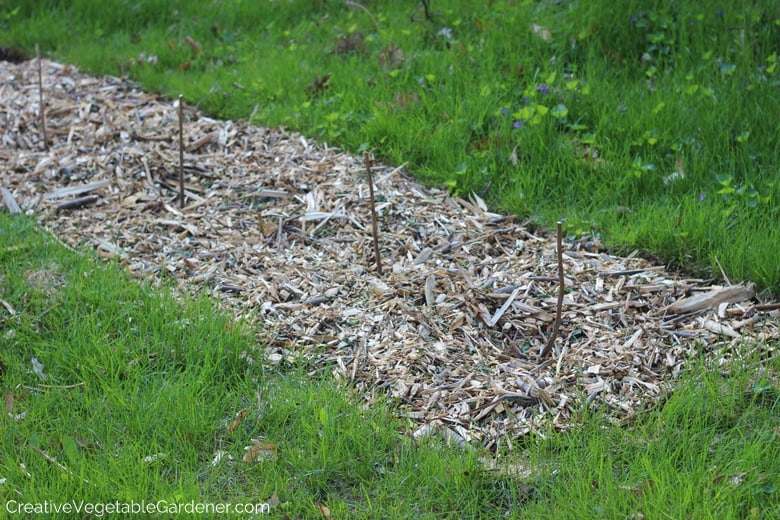









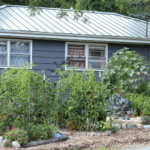

Comments
I have heard about an invasive fruit fly wreaking havoc on raspberry crops. Do you know if that affects summer bearing or fall bearing more? And do you have a plan for managing your raspberries if the fruit flies find them?
Also, how do you keep rabbits away from your plants?
Susan- The Spotted Wing Drosophila has been identified in WI and has ruined crops. It seems like it’s not appearing until later in the season and is affecting fall crops so far. I might stay away from fall bearing for a bit to see how it develops. I’ll keep the community posted. I don’t have problems with rabbits bothering my plants. They’ve never been fenced.